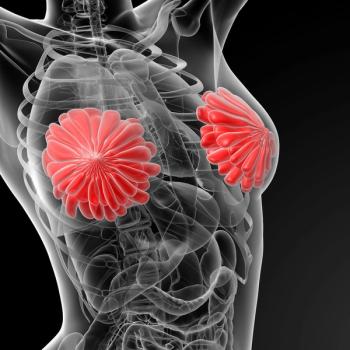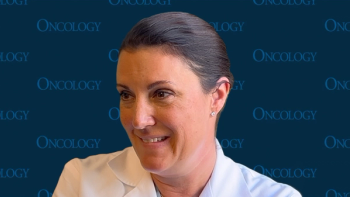
Oncology NEWS International
- Oncology NEWS International Vol 9 No 6
- Volume 9
- Issue 6
Efficacy of Adjunctive Therapy With Tamoxifen Depends on Tumor’s Hormone Receptor Status
San Antonio-New data presented at the 22nd Annual San Antonio Breast Cancer Symposium indicate that hormone-receptor status may play a critical role in the effectiveness of adding tamoxifen (Nolvadex) to adjuvant chemotherapy in high-risk node-negative breast cancer patients.
San AntonioNew data presented at the 22nd Annual San Antonio Breast Cancer Symposium indicate that hormone-receptor status may play a critical role in the effectiveness of adding tamoxifen (Nolvadex) to adjuvant chemotherapy in high-risk node-negative breast cancer patients.
The analysis indicates a significantly different effect of tamoxifen on receptor-positive and receptor-negative subgroups, said Laura Hutchins, MD, professor of medicine, University of Arkansas for Medical Sciences.
The S8897 Phase III Intergroup Study, conducted from 1989 to 1993, stratified 3,977 eligible patients with node-negative invasive breast cancer into risk groups, with high-risk patients defined as those having tumors of 2 cm or larger, any patient with a hormone-receptor-negative tumor, and those with hormone-receptor-positive tumors less than 2 cm with high S-phase fraction or greater than 1 cm with S-phase fraction unknown.
2,691 Randomized Patients
The 2,691 high-risk patients were randomized to one of four adjuvant therapy groups: CMF (cyclophosphamide, methotrexate, fluorouracil), 677 patients; CMF followed by 5 years of tamoxifen, 674 patients; CAF (cyclophosphamide, Adria-mycin, fluorouracil), 670 patients; and CAF plus tamoxifen, 670 patients. Results reported at the 1998 ASCO meeting (Los Angeles) showed survival benefits for those on the CAF arms.
The new analysis of the effects of adding tamoxifen showed that, for all patients, there was no significant difference in the disease-free survival rate between those receiving chemotherapy alone (83%) and those receiving chemotherapy and tamoxifen (86%), Dr. Hutchins said. Similarly, there was no significant difference in the overall survival rate of those receiving chemotherapy alone (92%) vs those receiving chemotherapy plus tamoxifen (91%).
Receptor Subsets
A specific aim of the study was to test the effectiveness of tamoxifen within receptor subsets. This analysis detected a significant difference in 5-year disease-free survival with the addition of tamoxifen to chemotherapy in patients with receptor-positive tumors: 88% vs 82% for chemotherapy alone (P = .007). For overall survival, the advantage was 94% vs 92% (P = .02). No such advantage in disease-free or overall survival was found in receptor-negative patients.
The researchers then reviewed the data taking into account menopausal status. These subsets were not study goals, and therefore the results should be viewed as exploratory, Dr. Hutchins noted.
In the receptor-positive premenopausal group, the benefit of adding tamoxifen was small, with a 5-year estimated disease-free survival of 90% for chemotherapy plus tamoxifen and 86% for chemotherapy alone (P = .22). The results for overall survival were similar.
However, in the receptor-positive postmenopausal patients, the addition of tamoxifen showed a significant improvement, both in disease-free and overall survival. The disease-free survival in the receptor-positive postmenopausal patients was 86% with tamoxifen vs 76% without (P = .005). Overall survival was 93% vs 89% (P = .008).
In contrast, in premenopausal receptor-negative patients, tamoxifen led to worse outcomes. In these patients, 5-year disease-free survival was 88% for chemotherapy without tamoxifen vs 82% with tamoxifen (P = .05). Overall survival showed a similar direction: 89% for chemotherapy with tamoxifen vs 94% for chemotherapy alone (P = .15).
Finally, Dr. Hutchins said, there was no difference seen between chemotherapy alone or with tamoxifen in receptor-negative postmenopausal patients.
In summary, she said, in this study of high-risk node-negative breast cancer patients, the addition of tamoxifen to chemotherapy showed improved outcomes in hormone-receptor-positive patients only, with most of the benefit being seen in the postmenopausal group. There was no benefit seen in the overall population or in receptor-negative patients.
Further, she said, an exploratory subset analysis of receptor-negative, premenopausal patients showed a worse
outcome. These data, Dr. Hutchins said, should not be considered conclusive, but should cast doubt on any assumption that tamoxifen in premenopausal patients could not be harmful.
Articles in this issue
over 25 years ago
Genentech Issues Warning on Herceptinover 25 years ago
How Physicians Can Effect Changes in Health Care Policyover 25 years ago
Four From Congress Receive Tsongas Awardover 25 years ago
NCI Targets Cancer Disparities With Community-Based Programsover 25 years ago
Mapping Predicts Nodal Status in Colorectal Cancer Patientsover 25 years ago
SSO President Tells Members: ‘Remember Your Core Values’over 25 years ago
HHS Grants $794 Million in Ryan White Funds to Improve HIV Servicesover 25 years ago
Rapid Dose Titration With Controlled-Release Oxycodoneover 25 years ago
Standard-Dose Chemo May Have Long-Term Cognitive EffectsNewsletter
Stay up to date on recent advances in the multidisciplinary approach to cancer.


















































































